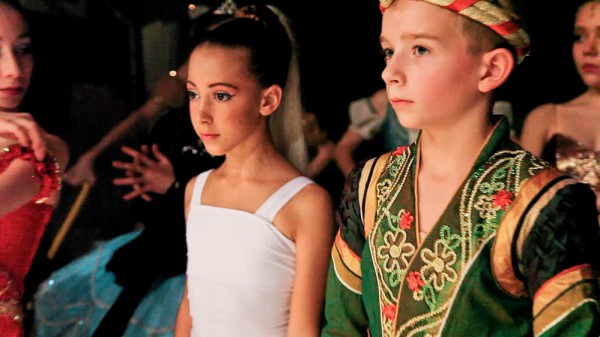“First Position” Intrigues and Inspires
Even if a night at the ballet strikes you as a snooze fest, you’ll find yourself mesmerized with dance during First Position. Don’t be surprised if by the end you’re on the edge of your seat rooting for young dancers as they overcome impossible circumstances. First time director Bess Kargman’s award-winning documentary offers an inside look at the training regime of child ballet dancers.
First Position follows seven kids from a range of cultural and socio-economic backgrounds and presents a disturbing, but moving peek into the obsessive world of ballet. The “first position” is the most basic ballet pose, but the title also refers to the coveted scholarships that the children compete for in an arena where competition is intense and disappointment is par for the course. They each vie for the “first” prize. We are watching the “crème de la crème.” Only the top thirty out of over five thousand can expect a top honor.
The film fascinates not only because it gives perspective on a somewhat secret world, but also because it focuses on youth—one of America’s preoccupations. Director Kargman (who also danced as a child), transcends the popular reality show genre that chronicles children pushed to extremes by their overzealous coaches and parents. Consider the hit pageant TV show Toddlers and Tiaras where 4 year-olds are coated in glitter, lipstick and rhinestones.
Also in this category, let’s add the locally filmed, Dance Moms. It features Pittsburgher Abby Lee Miller and her drama-filled dance studio, which sits on the outskirts of Penn Hills. Here local youngsters compete in a variety of supposedly important dance contests. The kids on Dance Moms would not survive for long in First Position’s “Youth America Grand Prix,” a competition that boasts the best dancers in the world and promises contracts from the globe’s most elite dance companies and academies.
First Position opens with shots of an empty stage before focusing on feet—images that continue throughout to emphasize the grueling nature of dance. Ballet appears delicate and graceful, while hiding the agony it takes to achieve its beauty. Ballet, in fact, as one dancer points out, makes the unnatural seem natural. We see shots of battered toes, wrapped in bandages—a long way from the pale pink tights in satin toe shoes the film begins with. The kids seem to glide on air, until late in the film when we recall the satin ribbon that seemed to cut into the slim ankles.
Dancers flex their calloused arches while we hear about “good feet,” so rare that few dancers have them. Good or bad feet make or break careers. The camera also focuses on tortuous-looking devices, feet stretchers. One young dancer Aran, age 11, advises that once you’ve done as many toe stretches as you can manage, “then do five more.” Another of the profiled dancers, Michaela, 14, may have her future crushed by a foot injury that threatens her crucial final performance. Pain is always underfoot as the price for the effortless looking beauty of the ballet.
First Position is compelling in its focus on the international and multicultural stories and histories of the dancers. The camera crew follows 16 year-old Joan Sebastian home to Colombia where he visits his family for the first time in over a year. We cannot help but notice his family’s poverty. The reunion is touching, but it takes place in his home—a domicile that seems to be missing walls. Joan Sebastian sighs with delight as he sips his family’s traditional dinner soup, cooked over a makeshift stove outside.
The film also provides an undeniable contrast in the stories of Rebecca, 17, (a self-described “Barbie”) and Michaela (whose adoptive parents wanted a child from war-torn Africa). The contrast between these two girls points out the stereotypes that persist in the ballet industry. Michaela’s mother has to dye the mesh and straps on her daughter’s ballet costumes dark brown, since the costumes only come in “flesh,” a light shade that does not match her daughter’s skin. Michaela is a remarkable dancer, but we cringe as her coaches claim that she is not “delicate” enough, that she is too “muscular.” Michaela is aware of the stereotypes about black ballerinas. She describes finding a ballet magazine in her orphanage in Sierra Leone and imagining herself as the beautiful dancer on its cover. Her plan is to start a ballet school in her home country one day.
In contrast, we view Rebecca in her white, upper-middle class suburban existence, complete with her own car and its “princess” bumper sticker. Coaches describe her as having the perfect body—a “small head” on top of a sleek, impossibly thin frame. While Rebecca represents the “average” American ideal, she claims that dancing in the Grand Prix competition is the scariest event she can recall. She stands in sharp contrast to the experiences of Michaela who witnessed the murders of those closest to her when she was a small child in Sierra Leone.
First Position also chronicles the stories of brother and sister, Jules and Miko, who are mixed race, Japanese and white. Their mother weeps when Jules, age 10, quits ballet. He would rather play Legos and claims his main talent is smiling. However, his sister Miko is an incredible dancer though only 12. She chooses home schooling to open up more hours for dance. Her father admits that she puts in longer hours than he does at his job. We also meet an Israeli girl, Gaya, age 11. Her mother remarks, “she becomes an adult when she dances.”
Ultimately, First Position is as much about the judges, parents, coaches and other adults who control, support, and sometimes destroy, the hopes and dreams of children. The kids we meet are all minors, some as young as 9, though the prize categories at the prestigious Grand Prix call them “women” and “men.”
By the documentary’s end, each child is well positioned for a remarkable future—though earlier, we hear one parent remark that they’ll be finished by age 35. Even still, the dance sequences will take your breath away. You may forget that you’re watching children.
First Position plays at the Harris Theater through June 28 and it is also available via On Demand.
More information at the film’s website and on facebook.
Look for the DVD in wide distribution Oct./Nov. 2012
Share on Social Media
Follow Entertainment Central
Latest Stories
Sign up for the EC Newsletter












